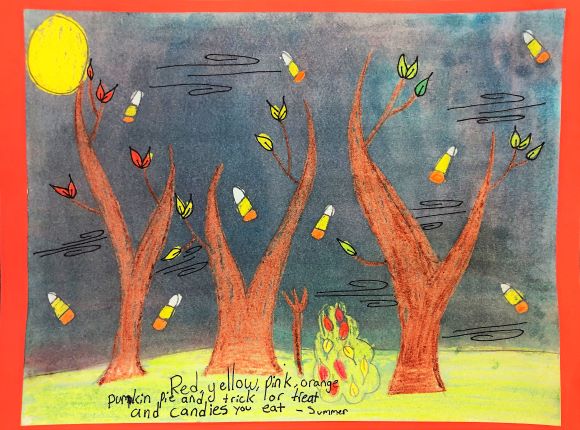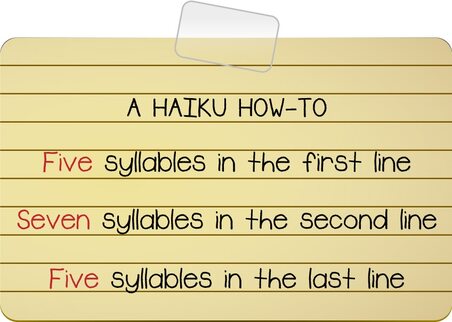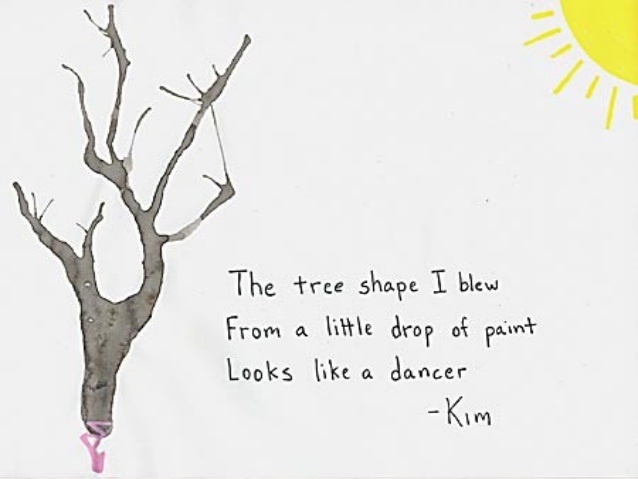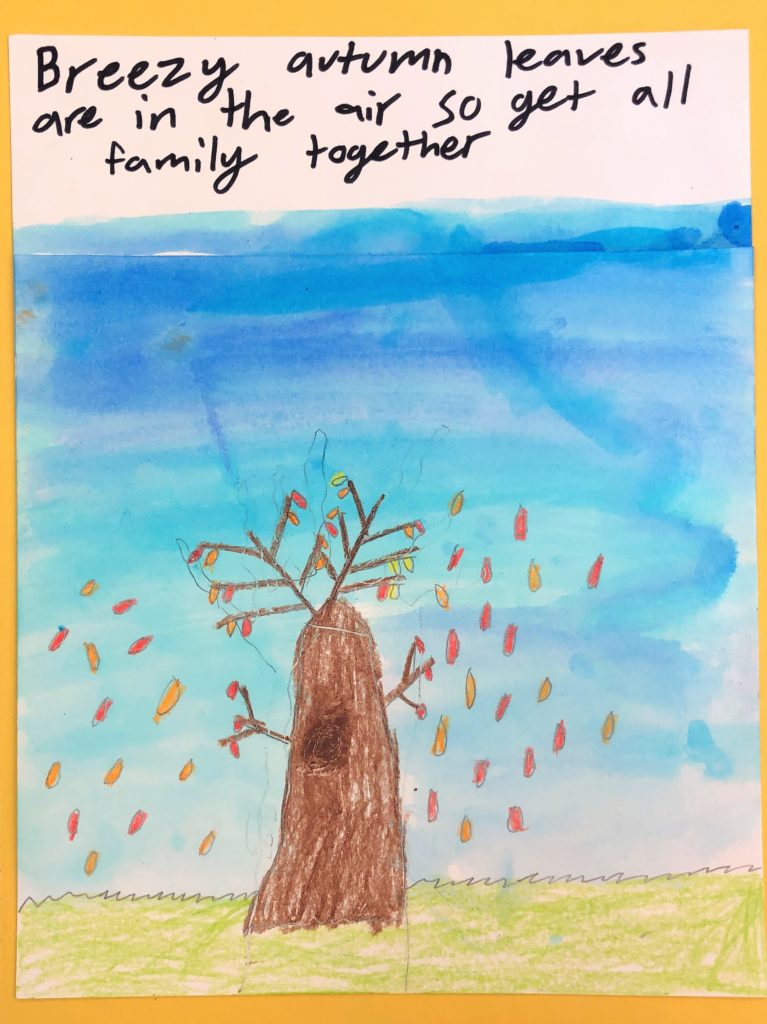
Originating from Japan, Haiku Poetry Art will support language arts, math and connects with science due to the fact that Haiku poems focus on nature. This project covers Common Core Standards for Language Arts, Math, Science and History for grades 1-8 which can be found at the end of the lesson.
Grade Level
1st, 2nd, 3rd, 4th, 5th, 6th, 7th, 8th. This project was created by 5th grade students.
Objective for Haiku Poetry Art
Students will use the style of Haiku poetry art to create a nature inspired poem based on a season that they illustrate.
Time
2 – 30 min lessons
Materials
- Black Sharpie Marker – Sharpie Permanent Marker, Fine Point, Black, Pack of 5
- 9×12 Watercolor paper – Canson (100510941) XL Series Watercolor Pad, 9″ x 12″, Fold-Over Cover, 30 Sheets
- Brushes – Acrylic Paint Brush Set, 1 Packs / 10 pcs Nylon Hair Brushes for All Purpose Oil Watercolor Painting Artist Professional Kits
- Liquid Water Colors – Sargent Art 22-6010 10-Count 8-Ounce Watercolor Magic Set
- Or this mini version for homeschooling – Sargent Art 22-6210 10-Count 4-Ounce Watercolor Magic
- Kleenex for blotting paint
Inspiration/Artist
I was inspired to make this Haiku Poetry Art project when I saw this post on The Butterfly Teacher: Click Here
Instruction with Questions
Day 1
Show students a famous piece of art set in Japan.

Walk them through a meditation for viewing art.
- Remove all distractions around you. Things that are busy visually and things that are noisy.
- Let distractions and everyday thoughts fall away.
- Focus only on the painting and your breath.
- Have your eyes travel over the artwork.
- Observe your reaction to the piece of art.
- What is your first impression? What catches your eye right away?
- How does the artwork make you feel?
- Notice your senses, what do you see, imagine smelling, touching etc.
- What season do you believe this artwork takes place in? Why do you think so?
- What questions do you have? Do you wonder about how the art is made or what is happening in the story of the artwork? Or maybe you are curious about the person who made the artwork?
- What deeper meaning do you see? Does the artwork make you think of some memory from your life? How do you feel when looking at the artwork?
Allow some quiet time following the questions.
Invite them to quietly have their attention return to the room they are in and back to the session.
Finally, ask students to share any impressions they had or any AHA! moments.
Next
Give students an overview about Haiku Poetry Art. This is a Japanese artform that gained popularity in the 1600s.
These are short poems that use a special pattern and focus on nature.
The pattern is 5-7-5. This is a great language art support for reinforcing syllables. I found this great overview…

The key is that these poems do not need to rhyme. They focus solely on nature and the syllable pattern.
Here are three examples of haiku poems from Matsuo Basho (1644-1694), considered the greatest haiku poet:
An old silent pond…
A frog jumps into the pond,
splash! Silence again.
Autumn moonlight-
a worm digs silently
into the chestnut.
In the twilight rain
these brilliant-hued hibiscus –
A lovely sunset.
And here is another example of a poem I found online.

First
Give students the vocabulary they need. Ask them to write down a list of 10 words that describe the artwork or if you are not using a piece of art, whatever season we are entering.
For this example, I was teaching 5th graders and was preparing for a Fall bulletin board. I remind them that nouns, adjectives, adverbs and verbs all work. If you wanted to, you could even have them break them into groupings to reemphasize these parts of speech. Anything they can think of that reminds them of Autumn count. Leaves, swirling, happily, orange, turkey, candy, etc.
Second
Next, go through the class calling on one student at a time to share their word without repeating any words. Students can either check if they already have that word, or add it to their list. It is awesome to see their blank faces turn into excitement as they add to their vocabulary list. One student exclaimed, “I have 27 words!!”
Third
Do an example of Haiku Poetry Art with the class as a whole. I grab some words from their lists. We clap out the syllables together. I let them know that they can play with the words. “Family” is three syllables. “Every” is two. These are tricky ones. The whole thing doesn’t need to be a full sentence, nor does each line need to be a full sentence. The goal is to capture the essence of the season.
Colored leaves fall down
Colors Red, Orange, Yellow, Brown
All change, color leaves
-Sophia G.
Another idea
You could use this genius idea from The Butterfly Teacher who uses QR codes with teaching Haiku. She also shares a link to another site that recommends Haiku books on Amazon. Check it out – Click Here

Fourth
Have students write a rough draft that you “clear” with them. Clap out the syllables as you read it with them to make sure they understand the formula. Check for spelling and any necessary punctuation. There only needs to be one punctuation mark at the end, and commas if necessary throughout. I make sure they sign their poem with their first name only. Finally, they illustrate their poem. Use whatever materials you have on hand. If possible, I recommend using watercolor paper, crayons or oil pastels and watercolors to illustrate their poem.
Check out these finished Haiku Poetry Art pieces!


























Common Core Standards for Haiku Art
Grades 1-8 – Language Arts
Children’s adventure stories, folktales, legends, fables, fantasy, realistic fiction, and myth. Includes staged dialogue and brief familiar scenes. Also included are nursery rhymes and the sub-genres of the narrative poem, limerick, and free verse poem Includes biographies and autobiographies
Grades 1 – 8 – Science
Investigation and Experimentation
Grade 1 – Math
Operations and Algebraic Thinking
Represent and solve problems involving addition and subtraction.
- Use addition and subtraction within 20 to solve word problems involving situations of adding to, taking from, putting
together, taking apart, and comparing, with unknowns in all positions, e.g., by using objects, drawings, and equations with
a symbol for the unknown number to represent the problem.2
Grade 1 – History
A Child’s Place in Time and Space
1.4 Students compare and contrast everyday life in different times and places around the world and recognize that some aspects of people, places, and things change over time while others stay the same.
3. Recognize similarities and differences of earlier generations in such areas as work (inside and outside the home), dress, manners, stories, games, and festivals, drawing from biographies, oral histories, and folklore.
Grade 7 – History (note: Haiku gained popularity in the 1600s)
7.5 Students analyze the geographic, political, economic, religious, and social structures of the civilizations of Medieval Japan.
7.11 Students analyze political and economic change in the sixteenth, seventeenth, and eighteenth centuries (the Age of Exploration, the Enlightenment, and the Age of Reason).

We did this project with secondary students giving them the option to choose the medium of their choice. Some of the projects captured the wonder of nature beautifully while others gave glimpses into the students themselves. One of my favorite projects, thanks again!